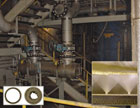
Self-cleaning filters help GPC reduce maintenance manpower and material costs and extend the useful life of the materials while boosting energy efficiency. Source: Tekleen.
One of GPC’s heavy industrial processes is in its Washington, IN, facility, where it produces cornstarch and alcohol. Derrick Biggs, maintenance supervisor at the Indiana facility, says, “Our main goal is to get the cornstarch out, convert the starch to sugar and the sugar to alcohol.”
Biggs started using Tekleen self-cleaning filters in the feed and milling area (where corn enters, and separation is done) to address the problem of solids in the process water, which can run as high as 12% and clog the heat exchangers. Prior to using self-cleaning filters, solids would build up, and the heat exchangers would have to be pulled off line every two to four months for cleaning. The task took maintenance crews several days to complete. GPC had tried some cartridge filters, but they needed frequent cleaning, so the company decided to experiment with self-cleaning filters.
Ultimately it selected Tekleen stainless steel filters, which use a self-cleaning mechanism that allows uninterrupted flow of filtered water even while cleaning takes place. The procedure also uses a fraction of the water that normal back-flushing requires.
In this design, the dirty water flows in and around the outside of a coarse filter, removing larger particles. This pre-filtered water then flows to the other end of the filter housing where it passes from the inside to the outside of the final filter and then through the outlet. At the outlet an adjustable pressure differential switch opens the small flush valve, initiating the cleaning procedure.
Rather than taking the full water flow to initiate a complete backwash, the Tekleen filters have a number of small cleaning nozzles around a central shaft. Opening the flush valve lowers the water pressure within the cleaning unit, and the nozzles vacuum the dirt from the inside surface of the filter screen. A hydraulic motor and piston cause the nozzles to rotate and move axially in order to cover the entire screen surface in five to ten seconds. At that point, the flush valve closes and the cleaning mechanism returns to its starting position. Other than a small control voltage for the differential pressure sensor to actuate the flush valve, all motions involved in cleaning the filter are performed using the water pressure.
“The filters definitely saved us a lot of manpower in cleaning the heat exchangers and replacing gaskets,” he says. “The gaskets are extremely expensive and every time you take the heat exchangers apart you most likely have to replace them.”
Based on the success of the first application, Biggs started using Tekleen filters on a cloth wash system that uses rotary vacuum drum filters. Biggs reports that he now has four filters in use and, based on the success at the Indiana facility, GPC started using the Tekleen filters in its Muscatine, IA, facility. u
For more information: Automatic Filters; 310-839-2828;www.tekleen.com